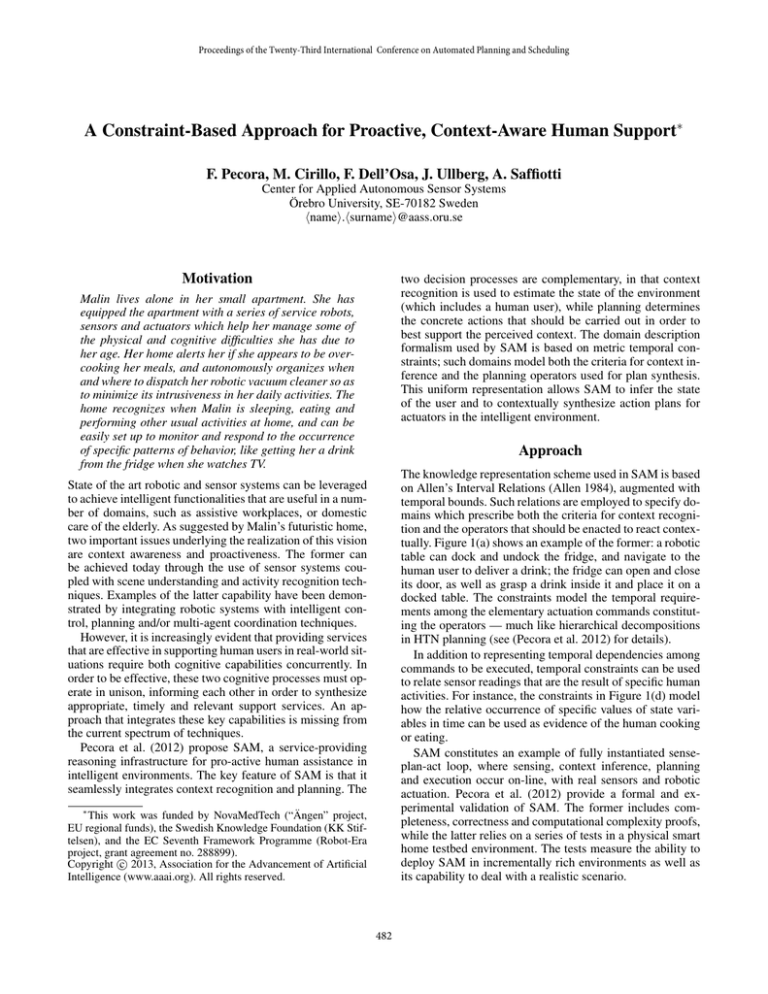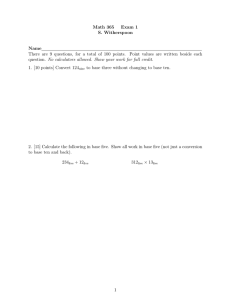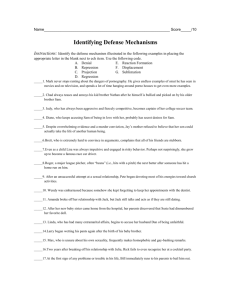
Proceedings of the Twenty-Third International Conference on Automated Planning and Scheduling
A Constraint-Based Approach for Proactive, Context-Aware Human Support∗
F. Pecora, M. Cirillo, F. Dell’Osa, J. Ullberg, A. Saffiotti
Center for Applied Autonomous Sensor Systems
Örebro University, SE-70182 Sweden
hnamei.hsurnamei@aass.oru.se
Motivation
two decision processes are complementary, in that context
recognition is used to estimate the state of the environment
(which includes a human user), while planning determines
the concrete actions that should be carried out in order to
best support the perceived context. The domain description
formalism used by SAM is based on metric temporal constraints; such domains model both the criteria for context inference and the planning operators used for plan synthesis.
This uniform representation allows SAM to infer the state
of the user and to contextually synthesize action plans for
actuators in the intelligent environment.
Malin lives alone in her small apartment. She has
equipped the apartment with a series of service robots,
sensors and actuators which help her manage some of
the physical and cognitive difficulties she has due to
her age. Her home alerts her if she appears to be overcooking her meals, and autonomously organizes when
and where to dispatch her robotic vacuum cleaner so as
to minimize its intrusiveness in her daily activities. The
home recognizes when Malin is sleeping, eating and
performing other usual activities at home, and can be
easily set up to monitor and respond to the occurrence
of specific patterns of behavior, like getting her a drink
from the fridge when she watches TV.
Approach
The knowledge representation scheme used in SAM is based
on Allen’s Interval Relations (Allen 1984), augmented with
temporal bounds. Such relations are employed to specify domains which prescribe both the criteria for context recognition and the operators that should be enacted to react contextually. Figure 1(a) shows an example of the former: a robotic
table can dock and undock the fridge, and navigate to the
human user to deliver a drink; the fridge can open and close
its door, as well as grasp a drink inside it and place it on a
docked table. The constraints model the temporal requirements among the elementary actuation commands constituting the operators — much like hierarchical decompositions
in HTN planning (see (Pecora et al. 2012) for details).
In addition to representing temporal dependencies among
commands to be executed, temporal constraints can be used
to relate sensor readings that are the result of specific human
activities. For instance, the constraints in Figure 1(d) model
how the relative occurrence of specific values of state variables in time can be used as evidence of the human cooking
or eating.
SAM constitutes an example of fully instantiated senseplan-act loop, where sensing, context inference, planning
and execution occur on-line, with real sensors and robotic
actuation. Pecora et al. (2012) provide a formal and experimental validation of SAM. The former includes completeness, correctness and computational complexity proofs,
while the latter relies on a series of tests in a physical smart
home testbed environment. The tests measure the ability to
deploy SAM in incrementally rich environments as well as
its capability to deal with a realistic scenario.
State of the art robotic and sensor systems can be leveraged
to achieve intelligent functionalities that are useful in a number of domains, such as assistive workplaces, or domestic
care of the elderly. As suggested by Malin’s futuristic home,
two important issues underlying the realization of this vision
are context awareness and proactiveness. The former can
be achieved today through the use of sensor systems coupled with scene understanding and activity recognition techniques. Examples of the latter capability have been demonstrated by integrating robotic systems with intelligent control, planning and/or multi-agent coordination techniques.
However, it is increasingly evident that providing services
that are effective in supporting human users in real-world situations require both cognitive capabilities concurrently. In
order to be effective, these two cognitive processes must operate in unison, informing each other in order to synthesize
appropriate, timely and relevant support services. An approach that integrates these key capabilities is missing from
the current spectrum of techniques.
Pecora et al. (2012) propose SAM, a service-providing
reasoning infrastructure for pro-active human assistance in
intelligent environments. The key feature of SAM is that it
seamlessly integrates context recognition and planning. The
∗
This work was funded by NovaMedTech (“Ängen” project,
EU regional funds), the Swedish Knowledge Foundation (KK Stiftelsen), and the EC Seventh Framework Programme (Robot-Era
project, grant agreement no. 288899).
c 2013, Association for the Advancement of Artificial
Copyright Intelligence (www.aaai.org). All rights reserved.
482
MovingTable : DockFridge
MET-BY Fridge : open
MovingTable
MovingTable : UndockFridge
BEFORE [0, ∞) Fridge : close
Fridge
DockFridge
open
MovingTable : DeliverDrink
AFTER [0, ∞) Fridge : PlaceDrink
UndockFridge
PlaceDrink
DeliverDrink
close
time
(c)
(a)
(b)
Human
Human : Cooking
EQUALS Stove : ON
DURING Location : KITCHEN
Cooking
Location
KITCHEN
Human : Eating
AFTER Human : Cooking
DURING Location : KITCHENTABLE
(d)
Eating
KITCHENTABLE
Stove
OFF
OFF
ON
time
(f)
(e)
Figure 1: Top row: three operators in a domestic robot planning domain (a), the corresponding real actuators available in our intelligent
environment (b), and a possible timeline for the corresponding plan (c). Bottom row: temporal constraints modeling a domestic activity
recognition domain (d), the corresponding situations as enacted by a test subject (e), and a possible timeline for the three state variables (f).
Image courtesy of IOS Press / Journal of Ambient Intelligence and Smart Environments.
Discussion
Fratini, S.; Pecora, F.; and Cesta, A. 2008. Unifying Planning and Scheduling as Timelines in a Component-Based
Perspective. Archives of Control Sciences 18(2):231–271.
Ghallab, M., and Laruelle, H. 1994. Representation and
Control in IxTeT, a Temporal Planner. In Proceedings of
the 2nd International Conference on Artificial Intelligence
Planning and Scheduling (AIPS).
Graf, B.; Hans, M.; and Schraft, R. 2004. Mobile robotassistants: issues for dependable operation in direct cooperation with humans. IEEE Robotics and Automation Magazine
2(11):67–77.
Jonsson, A.; Morris, P.; Muscettola, N.; Rajan, K.; and
Smith, B. 2000. Planning in Interplanetary Space: Theory and Practice. In Proc. Int. Conf. on AI Planning and
Scheduling (AIPS-00).
Knight, R.; Rabideau, G.; Chien, S.; Engelhardt, B.; and
Sherwood, R. 2001. Casper: Space exploration through continuous planning. IEEE Intelligent Systems 16(5):70–75.
McGann, C.; Py, F.; Rajan, K.; Ryan, J.; and Henthorn, R.
2008. Adaptive control for autonomous underwater vehicles. In Proceedings of the 23rd National Conference on
Artificial Intelligence (AAAI).
Muscettola, N.; Dorais, G.; Fry, C.; Levinson, R.; and
Plaunt, C. 2002. IDEA: Planning at the core of autonomous
reactive agents. In in Proceedings of the 3rd International
NASA Workshop on Planning and Scheduling for Space.
Pecora, F.; Cirillo, M.; Dell’Osa, F.; Ullberg, J.; and Saffiotti,
A. 2012. A constraint-based approach for proactive, contextaware human support. Journal of Ambient Intelligence and
Smart Environments 4(4):347–367.
Sisbot, E.; Marin-Urias, L.; Alami, R.; and Siméon, T. 2007.
A human aware mobile robot motion planner. IEEE Transactions on Robotics 23(5):874–883.
SAM employs concepts drawn from constraint-based planning and execution frameworks in conjunction with efficient temporal reasoning techniques for activity recognition. The approach builds on previous results in continuous planning, e.g., IxTeT (Ghallab and Laruelle 1994),
OMPS (Fratini, Pecora, and Cesta 2008), the NASA planning infrastructures (Jonsson et al. 2000; Knight et al. 2001;
Muscettola et al. 2002) and the T-REX model-based executive (McGann et al. 2008). SAM introduces a key novelty, namely a single architecture that integrates recognition and planning/execution abilities. These two aspects of
activity management are uniformly represented in a single
constraint-based formalism, reasoned upon by the same inference mechanism, and anchored to the real world through
specialized interfaces with physical sensors and actuators.
SAM also contributes to the development of human-aware
planning approaches. Existing approaches have focused on
specific aspects of human-aware planning, e.g., robot motion planning (Sisbot et al. 2007) and safety (Graf, Hans, and
Schraft 2004), or are based on the assumption that human
plans are given in advance (Cirillo, Karlsson, and Saffiotti
2009). The focus in SAM lies at a higher level of abstraction and involves the contextual and proactive generation of
assistive plans.
References
Allen, J. 1984. Towards a general theory of action and time.
Artificial Intelligence 23(2):123–154.
Cirillo, M.; Karlsson, L.; and Saffiotti, A. 2009. A humanaware robot task planner. In Proceedings of the 19th International Conference on Automated Planning and Scheduling
(ICAPS).
483






